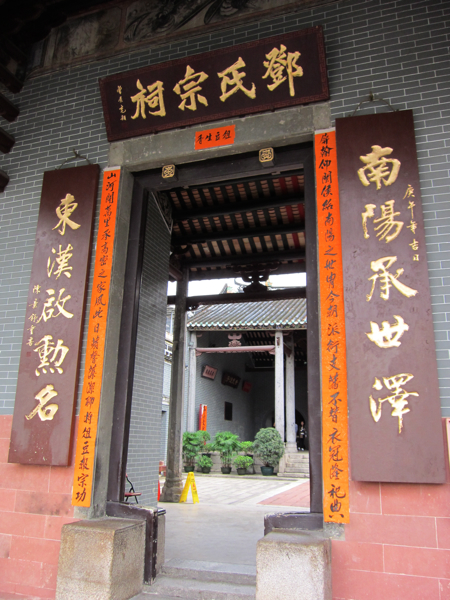Tang clan ancestral halls for the remembrance and veneration of the family forebears - these were built in the 19th century, although they were preceded by older ones on the site as early as the 16th. The Tangs were/are prominent in the Hakka community in this area and a lot of the sites on the trail are connected to or built by them. To the left of the photo there was a booth run by an old couple selling homemade snacks and candies, including a delicious sesame seed candy that I munched on for the next few days. Wish I'd gotten a photo of them. Wish I'd bought more of that candy.
Another (comparatively rare, in my experience) communist Chinese flag flew near the parking lot:
Inside the temple:
I wonder if figures like these inspired the mogwai in the movie Gremlins:
Not part of the original decoration:
The other ancestral hall right next door:
It's a little hard to tell in this shot, but this is a relief sculpture. Of what, I'm not sure, but I like it and if anyone can find a real live one, I want it:
Some British official at some ceremony with the community in the early 20th century:
This guardian on the door is meant to keep away bad spirits, a category which apparently does not include tourists:
Detail of the front of his outfit:
Some sort of outdoor drinking/eating establishment on one of the streetish alleys or alleyish streets along the trail. That's pop music and movie idol Andy Lau on the green ad banner at left:
If I'm recalling things correctly 10 months after the fact, the place below is a Tang clan study hall. Male members could cram here for the imperial examinations that were used to select officials for the vast Chinese bureaucracy. The examinations were extremely difficult and were one of the very few paths to rise socially and economically - having a member who passed the exams was a prestigious event for a family and even the whole community.
People must have tripped a lot moving from room to room in old Chinese homes:
The study hall is connected to a 19th-century guesthouse next door:
Old China, like medieval Europe, excelled marvelously at the Depiction of Beasties:
Contrary to Gothic Western traditions, though, bats like the one above were considered auspicious creatures.
Front of the guesthouse:
Down the lane a short distance, I took a while to find my last stop on the trail - the stone front gate of another study hall, which remains standing after, amazingly enough, the rest was torn down and apartment buildings built around and behind it in the 1980s. I had to find my way down this alleyway not much wider than my shoulders, glancing into people's living rooms and kitchens through their windows. That narrow corridor at the back is lined with the front doors of apartments (closer view in the second photo below).
You can still see the faded guardian figure painted on what used to be the temple entrance:
A metal rack holds resident's shoes beneath a beautiful carving dating from the 19th century:
Details below of the carvings, which depict scenes from The Water Margin and The Romance of the Three Kingdoms, revered classical novels of war and adventure that, among their other achievements, provide material for countless martial arts movies and TV shows.
Views of the New Territories on the train ride back:










































No comments:
Post a Comment